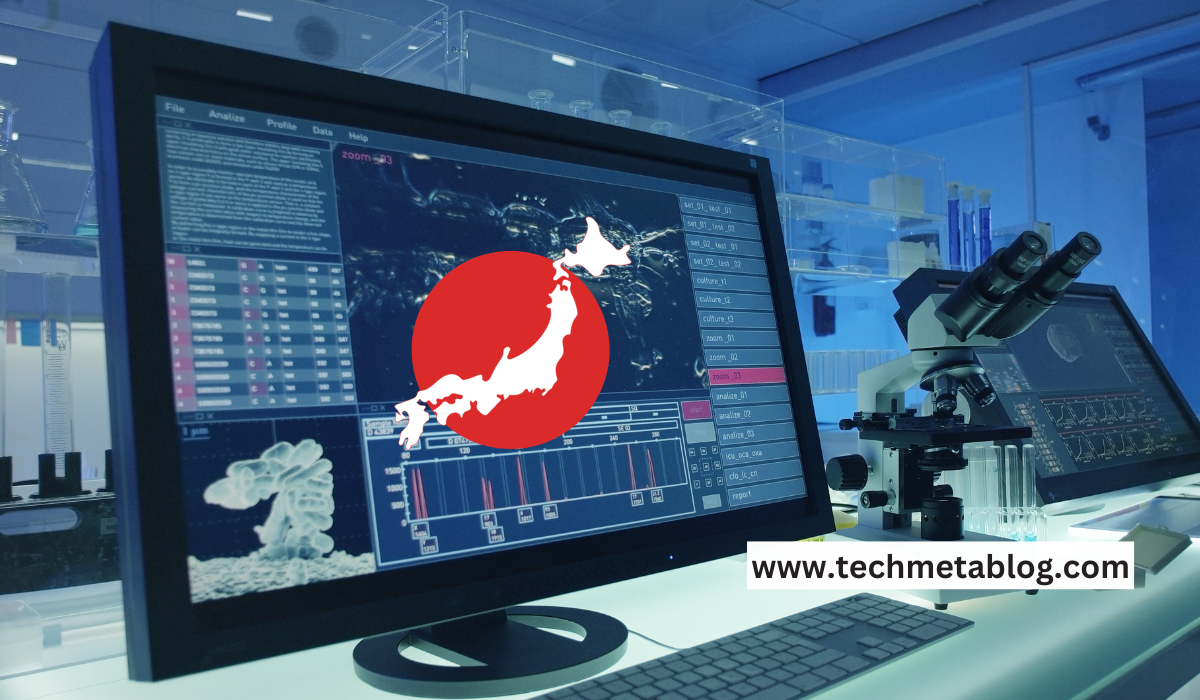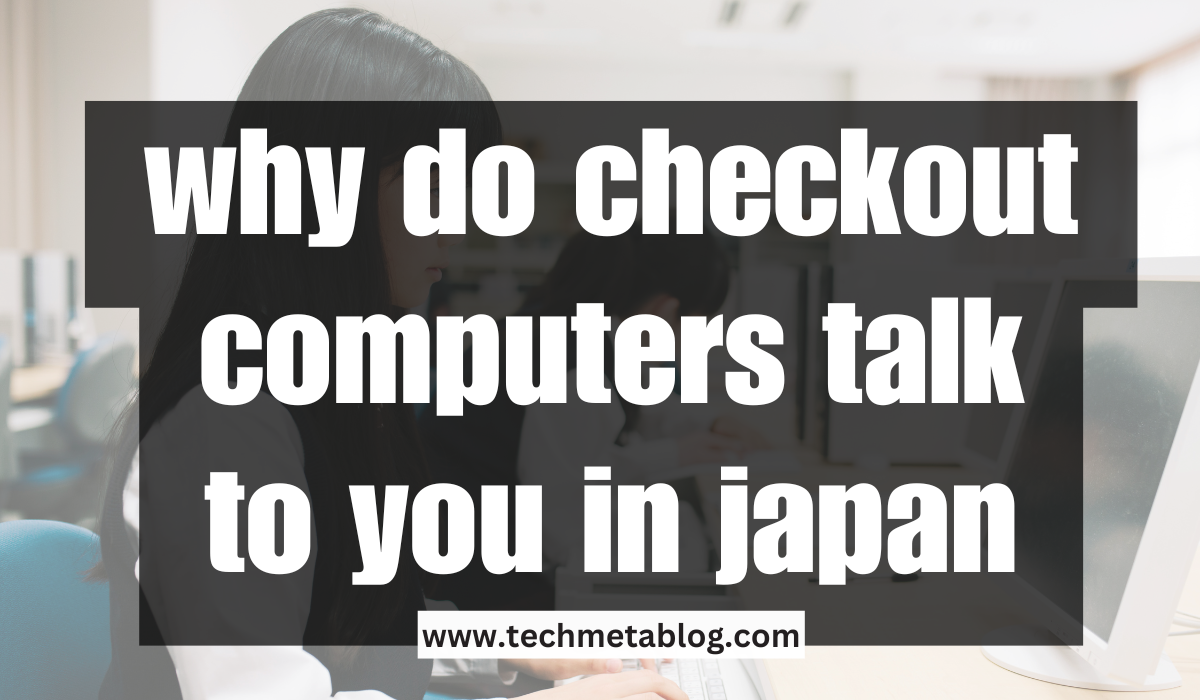In Japan, the checkout computers in retail setups engage their customers as part of a more comprehensive attempt at making shopping into an experience that involves superior technology and cultural values. It is not a simple streamlining of the transaction process but is ingrained much deeply into Japan’s culture of polite and respectful services for customers. Voice interaction at the checkout counters simplifies transactions, minimizes confusion, and promotes higher levels of customer satisfaction. These AI and machine learning technology-driven systems highlight Japan’s trademark for leading-edge innovation in technology and its vision of excellent service in every contact.
Why Do Checkout Computers Talk to You in Japan?
Clear Communication Enhances User Experience
Checkout computers in Japan communicate with the customers in allowing them a smooth, easy experience. These systems lead customers through the checkout process clearly and at their own pace. For example, one day they may teach them how to scan their items, apply the discounts correctly, and check out the customer with no mess up or delay in the actual process.
To the Japanese consumer, accuracy and direction are important. A culture of easy service will bring customers a hassle-free experience when using talking checkout systems. What this does is ensure that they do not commit basic errors in transactions, from simply scanning items wrong to making payment slips that go awry, ensuring an easy transaction from beginning to end.
Incorporating Cultural Accommodation to Match Technological Preference
According to a 2023 survey by Japan Consumer Research, 82% of Japanese shoppers opt for voice-enabled systems over traditional checkouts simply because they find voice-enable easier and more convenient. This is most relevant among the younger shoppers, who are highly comfortable with technology and expect it to be a convenient addition to their retail experience.
It is observed that Japanese consumers tend to be early adopters of technology, so even in the retail sector it is not an exception. Voice technology integration with checkout systems fulfills the needs of a population that thrives upon the need for speed, accuracy, and innovation in shopping.
Japanese Cultural Norms
All services in Japan are politeness and respect-a feature extending to even interactions with the machines themselves. The voice-sensations given by checkout computers most often belong to a polite, respectful tone, almost mimicking the behavior of a cashing human. This is a country that respects its customers and creates “respected” conduct in manners, even when using automatic systems.
Since other nations will perceive self-service as a less personal experience, the Japanese consumer is given the perception of having interacted personally through the talking checkout computers. About the aspect of providing the correct welcoming of the customer and giving the same rules within the checkout procedure, these systems assure the high standards of service that Japanese consumers give.
Artificial Intelligence in Checkout Systems
AI Influence on Retail in Japan
AI is huge on getting checkout computers in Japan to “speak.” Using the full concept of NLP, part of AI, these types of systems comprehend and generate human-like speech in determining what needs to be done. By this support in technology, check out systems can actually make time-for-time assistance, demonstrate how customers can execute their transactions, and even inform them what likely to be bought.
According to Japan’s Institute for AI Research, AI in Japan’s retail industry is expected to grow over 10% annually by 2025, with voice-enabled systems at the forefront of that development. AI enables transactions to be completed faster and more accurately than through human intervention and also assists retailers to gain insights into customer behavior by analyzing transaction data.
Implementation of Machine Learning for Personalization
Checkout computers in Japan, those that are voice-enabled, learn as they go along with the customers. This is brought about by the use of machine learning algorithms such that these kinds of systems can learn to become more and more personalized. That is, if a customer often buys the same thing, then maybe the system may automatically suggest those items during checkout, thereby making this whole process easier.
This is what makes personalization at such a level necessary to boost customer satisfaction. Based on the findings in RetailTech Japan, 75% of Japanese consumers view AI-driven recommendations as helpful and not intrusive; therefore, they like them. Talking checkout systems infuse a personal touch into the process; otherwise, one might argue that such methods for presenting the overall retail experience are commendable.
Cultural Impact: The Significance of Politeness and Service
Japan’s Strict Cultural Customs in Politeness
One reason checkout computers in Japan speak to customers is that such a culture as Japan teaches politeness and respect. The culture deeply instills “omotenashi,” which forms part of the idea of hospitality that considers what the customer needs. Service from whomever-the human or machine-should be courteous and respectful.
Japanese checkout systems usually carry honorific tones when addressing clients and the voice itself is muted so that it is not offensive. It is these minuscule details that culture sensitivity makes the customer feel like a superior being when conversing with the machine. Such systems there give an entirely hassle-free shopping experience, which is synonymous with Japan’s high standards concerning better customer service.
Adapting AI to the Japanese Politeness Standards
In an attempt to simulate the politeness characteristic of the Japanese culture, AI-driven checkout system developers have been delicate to ensure that the system falls within its expectations. Voice-based technologies, in such systems, are typically designed with strict rules on how addresses for customers ought to be used. For example, the greeting may be begun using a polite address and then be characterized by formal phrases as the transaction progresses. This kind of detail builds up a more personal experience-an experience like that of a human-being-for customers.
Fujitsu reports that 89% of Japanese customers believe politeness and respect are essential features of customer service, even in service exchanges involving technology. The voice-enabled checkout meets the culture requirements for these consumers.
Advancement of Customer Experience with Politeness and Efficiency
One of the most important reasons voice-assisted checkout systems have been applied across Japan is their contribution to helping a retailer find an easy balance between efficiency and politeness. In the retail environment that rapidly pulsates, customers have to be served quickly without compromising the quality of service by losing respect for cultural standards. Voice-assisted checkout systems stand out as the perfect solution for this problem-efficiency and swiftness without losing politeness.
For example, an automatic shop counter can be designed so that it will thank the customer for shopping at the store and remind him or her to collect the change. This combination of speed, precision, and politeness adds an element of comfort to the whole shopping process.
Technological Advancement: Voice Interaction in Japanese Retail
Implementation of Voice Interactive Check-out machines in Leading Retail Stores
Major retail chains have included voice-enabled checkout systems mainly in Japan. Companies including Seven & I Holdings, parent firm of 7-Eleven, have rolled out voice-enabled systems for more than 10,000 stores operating in Japan. Indeed, voice-enabled systems are found in most supermarkets and convenience stores in Japan, thus offering the swift and intuitive form of payment.
For Foreign Tourists and Non-Japanese speakers
Voice-enabled self-checkout systems can interact with local shoppers and foreign tourists. Most systems are there equipped to be bilingual, making them converse in Japanese and English. This feature is extremely important in tourist spots, wherein shoppers would probably not know the language or understand how to operate the self-checkout system.
According to a 2019 report by the Japan’s Ministry of Economy, Trade, and Industry, over half of all sales outlets responded that they used voice assistance in at least two different languages. This can make shopping easier for either tourists or local consumers, but it also frees non-Japanese-speaking store employees from having to personally answer questions from store customers, which decreases the overall inefficiency associated with direct involvement of the store employees.
Japanese Retail Chains Percentage Utilizing Voice-Enabled Checkout Systems (2023)
| Retail Chain | Percentage of Stores Using Voice-Enabled Systems |
|---|---|
| Seven & I Holdings (7-Eleven) | 85% |
| Lawson | 75% |
| FamilyMart | 72% |
| Aeon | 68% |
| Ito-Yokado | 62% |
Source: Ministry of Economy, Trade, and Industry, 2023
Voice-Enabled Checkout Systems and the Role of Customer Satisfaction
Elevating Customer Satisfaction through Personalization
The most basic but critical element of the retailing sector of Japan is customer satisfaction. Voice-enabled checkout systems can be of significant use to this particular area. The instructions regarding their process are clear and polite, helping customers feel more assured and less rushed during this process. This would be quite key in a country like Japan, where detail analysis and customer satisfaction are primary concerns.
A company from Japan and considered one of the biggest players in retail technology solutions made a research that showed that there was a 15% boost in the level of customer satisfaction on shops whose systems allowed employees to use voice-enabled check out.
More so, the study was such a revelation that showed that with such a system, customers were more likely to return to the stores because checkout was faster.
Making the Checkout Process Faster and More Efficient
Some of the other benefits of voice-enabled checkout systems is that they bring about improved customer satisfaction and reduce the checkout time. These are very strong retention factors and the most frequent complaints made by retailers are in regards to long lines and slow processes at checkout, so Japan’s voice-assisted systems help alleviate those problems.
According to RetailTech Japan, the checkout time within a store decreased by 10% in stores that had voice-enabled systems from those without voice-enabled systems. It not only benefits a customer because it makes the whole process a little faster but also helps streamline more transactions for retailers, thus spurring sales.
Voice-Assisted Technology: The Boom for Sales
Voice-enabled systems are not only looking into giving better service to the customer; it can directly attract sales, at least when it happened in the areas the retailer was practicing. There were sales increases as reported by retailers due to streamlined checkout processes that would otherwise leave customers frustrated after some have abandoned their purchases. More transactions are completed when given more streamlined and simpler execution, and voice-assisted checkout does all that.
According to Statista, the sales of Japanese stores having voice-assisted systems showed an increase of 7% as compared with those that have no voice-assisted systems. The main reason why sales increased is due to the fact that voice assistance minimized the propensity for error and also speeds up the transaction process, which makes shopping easier and fun to experience for its customers.
The Role of Data and Statistics in Voice-Enabled Checkout Systems
Data to Improve Customer Experience
One of the most important advantages of voice-enabled checkout systems is data collection and analysis. Every transaction offers valuable information with respect to consumer behavior that retailers can use for making the shopping experience a better one. For example, they can check how the customers operate the voice system, identify areas that bring along pain points, and then modify them to ensure more efficiency.
According to a study from Deloitte, voice-enabled systems retailers providing optimized customer experience increase customer retention by 12%. By using the feedback that is gained from the customers and continuing to develop the system, it will ensure that the voice-enabled checkout systems are effective and efficient.
Impact of Voice-Enabled Systems on Data Security
Even though voice-enabled checkout systems offer a plethora of benefits, they do leave some really serious issues with respect to the security of the data. In the case of Japan where data privacy is a very sensitive affair, those retailers have had to ensure that the data being collected from these systems is well-guarded. In response to this, most retailers followed sophisticated encryption methodologies and very strict protocols for the handling of data.
A report by Japan Institute of Data Privacy shows that 90% of customers will be likely to use voice-enabled systems if assured of the safety of data about them. Retailers have even invested heavily in cybersecurity to ensure that customer information is not exposed and maintain trust in the system.
Consumer Concerns Regarding Data Security in Voice-Enabled Systems (2023)
| Concern | Percentage of Respondents |
|---|---|
| Fear of data breaches | 45% |
| Concerns about data collection | 35% |
| Lack of transparency from retailers | 20% |
Source: Japan Institute of Data Privacy, 2023
Japanese Retail Future for Voice Technology
How AI and Voice Assistants Take Center Stage
Voice-enabled checkout systems are just the beginning of how AI is changing the Japanese retail landscape. The systems will continue to evolve, becoming further advanced and personal in their application toward helping customers in even more highly convenient and personalized ways. Natural language processing and machine learning will continue to advance, and these systems will be able to have even more natural and conversational contact with customers.
The research institute, Institute for AI Research in Japan, recently projected that voice-based AI systems in the retail industry will expand at 10% a year over the next five years. This growth will be mainly led by retailers looking to both increase efficiency and minimize expenses. All these considerations must translate to an improved overall experience for the customer.
More Applications for Voice Technology Beyond Checkouts
Voice technology has become widely used in checkout systems, but applications at retail are increasing by leaps and bounds. In some stores, they are even testing voice-enabled kiosks that can help the customer find a product, locate inventory levels, or get access to special deals. The same form of polite, user-friendly interactions with voice-enabled checkout are provided but then extended to the entire shopping experience in this system.
We’ll be seeing much more voice technology in the retail environment in the near future-from recommending the perfect size and color to the consumer to helping customers navigate the large floor areas of that giant superstore. The possibilities are virtually endless, and Japan will probably be leading the pack in years to come.
FAQs: Why Do Checkout Computers Talk to You in Japan?
Why are checkout computers talking?
Japan’s checkout computers speak to offer customer-friendly simple guidance throughout the whole process. This forms part of the factors that enhance efficiency and therefore customer satisfaction in the sales line. This goes in agreement with the culture of polite service in Japan.
Are voice-enabled checkout systems popular in Japan?
Yes, voice-enabled checkout systems are highly significant in Japan. Over 70% of retail stores apply this system to enhance a smooth shopping experience and still tend to increase.
Do voice-assisted checkout systems also improve customer satisfaction?
Yes, voice-assisted checkout systems have been proved to grow much the satisfaction of customers, about reduction of confusion, a check out speed, and amicable and clear instructions.
Is voice technology in Japanese retail growing?
Yes, voice technology in Japanese retail will increase by 10% every year during the next five years. More retailers are expected to adopt AI-driven systems, which will help with efficiency and also deliver improved customer experience.
Do Japanese consumers like to use the voice-assisted checkout systems?
Yes, most Japanese consumers like to use voice-assisted checkout systems. A survey conducted in 2023 found out that 82% of shoppers in Japan favor using voice-assisted checkout systems because they are convenient and easy to use.
Do these systems support multi-languages?
Yes, most of the voice-assisted checkout systems in Japan have Japanese and English in parallel. It is very convenient to use such devices in tourist intensive places.
Conclusion
Japan’s voice-enabled checkouts are a model for achieving perfect harmony between the technological and cultural realm in relation to its capacity to offer the best experience to its customers. These systems ensure that customers have a smooth and fast checkout, with cheerful guidance being polite and clear and providing just the right amount of efficiency. When the technology keeps advancing, voice technology will most likely be a more integral part of the retail sector, better suited to serve its customers with the most personalized and interactive experiences.
Leadership from Japan on this end results from the purpose it has to harmonize its quest for technological advancement with the need for sustaining high levels of customer service delivery; therefore, voice-enabled checkout systems form integral parts of the shopping experience in Japan.
Also read more : Ewe Said It NYT

